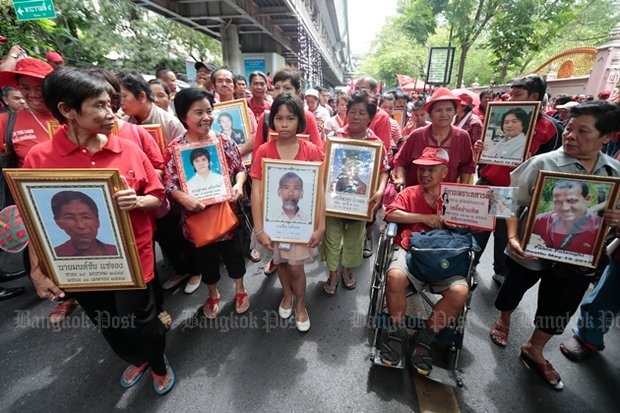
After six years, the Akkahad and Srithep families which lost their children in the fatal crackdown on red-shirt demonstrators in 2010 are undaunted and determined to pursue the task of seeking justice for their loved ones.
Pansak Srithep’s 17-year-old son, Samapan, was killed in the early dawn of May 15, 2010, on Ratchaprarop Road while Payao Akkahad’s 25-year-old daughter, and volunteer medic, Kamolkade was killed at the end of the crackdown on May 19, 2010, inside Wat Pathum Wanaram. They were among the 99 victims of the crackdown which followed three-month-long demonstrations against the Abhisit Vejjajiva government. There were more than 2,000 injuries.
Like other victims of political violence in this country and elsewhere in the world, these two families’ quests to bring the perpetrators to justice have been hampered all along, not just during the current military government.
It took two years before the Abhisit-sponsored Truth for Reconciliation Commission (TRC) could release some sketchy details of the probe results while the court inquest gave weight to military responsibility for the fatalities. Altogether 17 deaths, including Kamolkade's, were ruled by the Criminal Court as being the result of the military operations while 13 deaths are shrouded in ambiguity.
In September 2012, the TRC recommended that authorities address the legal violations perpetrated by all parties through the justice system in a fair and impartial manner.
The ensuing Yingluck Shinawatra government, while allocating compensation to hundreds of families of victims and survivors, was reluctant to meet demands by victims’ families and various scholars to take politicians and military top brass involved in the crackdown to the International Criminal Court. Instead, it opted for the controversial blanket amnesty bill which resulted in political mayhem and the 2014 coup.
Last week, Mr Pansak and Mrs Payao staged a symbolic walk for justice for their slain children. Six years on, they still feel betrayed and as though they have been denied justice for their unwarranted loss. This shows the determination of a mother and a father to see the perpetrator(s) brought to justice, rather than aiming for “historical justice” — a process to make state actors accountable for their past wrongdoings.
The families had some hope when the Justice Ministry’s Department of Special Investigation (DSI), in 2012, charged Mr Abhisit and Suthep Thaugsuban, then head of the Centre of the Resolution of the Emergency Situation (CRES), with murder and attempted murder for ordering the military crackdown on red-shirt protesters in 2010. No military men were charged, though. The case was brought to the Criminal Court.
The Criminal Court eventually ruled in 2014 that it had no jurisdiction to try Mr Abhisit and Mr Suthep because they were political office-holders at the time. Instead, the court referred the case to the National Anti-Corruption Commission (NACC), responsible for inquiries regarding abuse of official positions, to determine whether there was sufficient evidence to proceed with a case of malfeasance in the Supreme Court’s Criminal Division for Political Position-Holders.
The NACC voted unanimously on Dec 29 to clear Mr Abhisit, Mr Suthep and former army chief Gen Anupong Paojinda of malfeasance and dereliction of duty regarding the deadly crackdown.
The NACC resolution failed to appease the victims’ kin. It seems to contradict a report by Human Rights Watch which indicated soldiers started using live ammunition on the afternoon of April 10, 2010 — killing and wounding protesters, journalists and bystanders — many hours before the armed “men in black” militants, who operated in tandem with protesters, showed up and fought with soldiers.
Human Rights Watch’s May 2011 report, Descent into Chaos: Thailand’s 2010 Red Shirt Protests and the Government Crackdown, documented that excessive and unnecessary force by the military caused many deaths and injuries during the 2010 political confrontations.
The high number of casualties resulted in part from the enforcement of “live fire zones” around the United Front for Democracy against Dictatorship (UDD) protest sites. Sharpshooters and snipers were deployed by CRES to these zones.
The organisation also noted some elements of the UDD, including armed black-shirt militants, mounted deadly attacks on soldiers, police and civilians. Some UDD leaders incited violence with inflammatory speeches to demonstrators, urging their supporters to carry out riots, arson and looting.
The official account has also revealed that authorities used 111,303 rounds of ammunition from 11 March-19 May 2010. This included 2,120 sniper bullets.
Certainly, six years is relatively short compared to 32 years in Argentina’s quest to bring its military and politicians to justice for forced disappearances or 14 years before two South Korean leaders, former president Chun Doo-hwan and Roh Tae-woo, were convicted for the Kwangju massacre and corruption.
We should not let the Srithep and Akkahad families lead the fight for justice alone. It’s a responsibility of society to establish “historical justice” for the young victims.
Achara Ashayagachat is Senior News Reporter, Bangkok Post.




